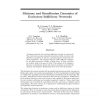Free Online Productivity Tools
i2Speak
i2Symbol
i2OCR
iTex2Img
iWeb2Print
iWeb2Shot
i2Type
iPdf2Split
iPdf2Merge
i2Bopomofo
i2Arabic
i2Style
i2Image
i2PDF
iLatex2Rtf
Sci2ools
NIPS
1997
1997
Minimax and Hamiltonian Dynamics of Excitatory-Inhibitory Networks
A Lyapunov function for excitatory-inhibitory networks is constructed. The construction assumes symmetric interactions within excitatory and inhibitory populations of neurons, and antisymmetric interactions between populations. The Lyapunov function yields su cient conditions for the global asymptotic stability of xed points. If these conditions are violated, limit cycles may be stable. The relations of the Lyapunov function to optimization theory and classical mechanics are revealed by minimax and dissipative Hamiltonian forms of the network dynamics. The dynamics of a neural networkwith symmetric interactionsprovablyconvergesto xed points under very general assumptions 1, 2 . This mathematical result helped to establish the paradigm of neural computation with xed point attractors 3 . But in reality, interactions between neurons in the brain are asymmetric. Furthermore, the dynamical behaviors seen in the brain are not con ned to xed point attractors, but also include oscillations an...
| Added | 01 Nov 2010 |
| Updated | 01 Nov 2010 |
| Type | Conference |
| Year | 1997 |
| Where | NIPS |
| Authors | H. Sebastian Seung, Tom J. Richardson, J. C. Lagarias, John J. Hopfield |
Comments (0)

